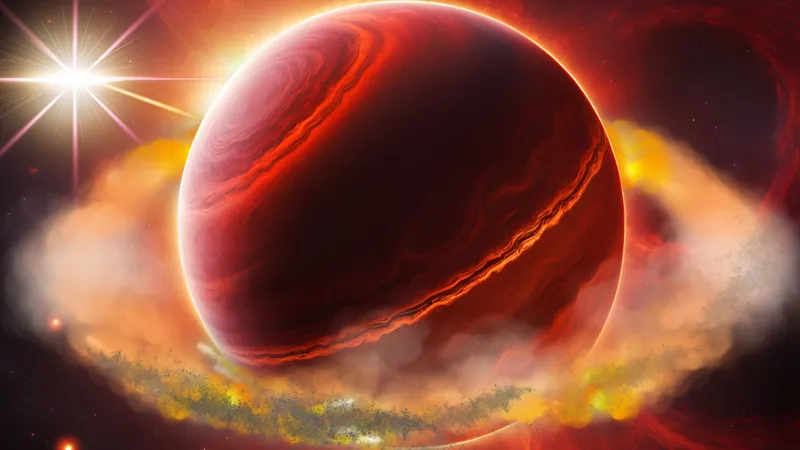
Exciting Discovery: Baby Pictures of Exoplanets Hint at Forming Exomoons Around Young Worlds!
2025-03-22
Author: Jia
Exciting Discovery of Exomoons Around Protoplanets
Astronomers have achieved a groundbreaking milestone by capturing stunning images of infant planets orbiting a distant star, unveiling the possibility of exomoons forming in the surrounding debris. These newly visualized planets, referred to as 'protoplanets,' revolve around a star named PDS 70, which is approximately 370 light-years away in the Centaurus constellation. Remarkably, PDS 70 is still in its early developmental phase at just 5 million years old—quite young compared to the 4.6 billion-year age of our own solar system.
Excitingly, researchers suggest that billions of years ago, our solar system may have closely resembled the dynamics seen in the PDS 70 system today.
Technological Advancements in Astronomy
A team of scientists from the University of Arizona utilized the advanced Magellan Adaptive Optics Xtreme (MagAO-X) technology in conjunction with the 6.5-meter Magellan Telescope located at the Las Campanas Observatory in Chile to produce these remarkable images. In a historic first, they observed variations in the brightness of the protoplanets, hinting at a dynamic and turbulent growth process.
Jialin Li, a doctoral student involved in the study, shared, 'We can now observe rings of dust enveloping these protoplanets, illuminated by starlight, showcasing the evolutionary process they undergo.' With only PDS 70 b and PDS 70 c confirmed in a catalog of over 5,000 exoplanets, this achievement illustrates how unique and rare protoplanets are.
The Nature of Protoplanets
The newborn planets are significantly large—each several times the mass of Jupiter—but as they are still relatively young, they continue to grow by absorbing matter from a surrounding protoplanetary disk of gas and dust. Team leader Laird Close elaborated on this, likening the massive planets to 'brooms or vacuum cleaners' that gather material from the disk while clearing a pathway around their star.
As these young celestial bodies draw in predominantly hydrogen gas, they emit light in the H-alpha wavelength range, a phenomenon known as 'shock heating' as the gas impacts the protoplanet's surface. The advanced technologies underpinning MagAO-X allow researchers to cut noise and distinguish clearly between the protoplanets and their circumstellar features, rivaling the capabilities of space telescopes.
Fluctuations in Brightness
In an intriguing observation over three years, PDS 70 b's brightness decreased to one-fifth of its original intensity while PDS 70 c's brightness doubled, pointing to fluctuations in the matter accretion rates of these planets. 'It’s as if one planet went on a diet while the other indulged in a feast,' explained Close, though the cause of these dietary changes remains a mystery.
Future Prospects in Astronomy
The success of the MagAO-X in observing these protoplanets is nothing short of revolutionary, using adaptive optics that correct atmospheric turbulence and eliminate stellar 'twinkling.' Close likened this technology to placing a telescope in outer space with just a click of a mouse, highlighting the crystal-clear resolution achieved.
As the endeavor continues, Close and his team are set to apply MagAO-X in their quest to identify more protoplanets around other young stars—potentially unveiling even more cosmic wonders and insights into the processes that lead to planet and moon formation. The implications of this research could provide invaluable knowledge about how exoplanets develop and the conditions that foster the formation of their moons, opening new chapters in our understanding of the universe.
Stay tuned for more astronomical revelations in the quest for cosmic understanding that could redefine our knowledge of planetary systems!


 Brasil (PT)
Brasil (PT)
 Canada (EN)
Canada (EN)
 Chile (ES)
Chile (ES)
 Česko (CS)
Česko (CS)
 대한민국 (KO)
대한민국 (KO)
 España (ES)
España (ES)
 France (FR)
France (FR)
 Hong Kong (EN)
Hong Kong (EN)
 Italia (IT)
Italia (IT)
 日本 (JA)
日本 (JA)
 Magyarország (HU)
Magyarország (HU)
 Norge (NO)
Norge (NO)
 Polska (PL)
Polska (PL)
 Schweiz (DE)
Schweiz (DE)
 Singapore (EN)
Singapore (EN)
 Sverige (SV)
Sverige (SV)
 Suomi (FI)
Suomi (FI)
 Türkiye (TR)
Türkiye (TR)
 الإمارات العربية المتحدة (AR)
الإمارات العربية المتحدة (AR)